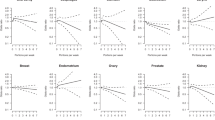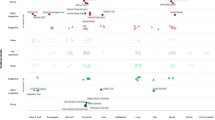Abstract
We investigated the association of melanoma risk with food consumption in a northern Italian population in which disease risk was shown to correlate with linoleic acid and soluble carbohydrates intake. We collected information regarding the habitual consumption of 188 food items in 59 patients with newly diagnosed cutaneous melanoma and 59 sex- and age-matched population controls. In the unadjusted analyses, the intake of several foodstuffs directly or inversely correlated with melanoma risk. In multivariate analysis adjusting for several potential confounders, risk correlated directly with vegetable oil intake and inversely with consumption of crispbreads and rusks. Overall, most of the food items rich in linoleic acid and soluble carbohydrates were unrelated to disease risk. Despite the limited statistical precision of the point estimates, these findings seem to indicate that consumption of specific foods may influence melanoma risk.
This is a preview of subscription content, access via your institution
Access options
Subscribe to this journal
Receive 12 print issues and online access
$259.00 per year
only $21.58 per issue
Buy this article
- Purchase on Springer Link
- Instant access to full article PDF
Prices may be subject to local taxes which are calculated during checkout
Similar content being viewed by others
References
Feskanich D, Willett WC, Hunter DJ, Colditz GA (2003). Dietary intakes of vitamins A, C, and E and risk of melanoma in two cohorts of women. Br J Cancer 88, 1381–1387.
Granger RH, Blizzard L, Fryer JL, Dwyer T (2006). Association between dietary fat and skin cancer in an Australian population using case–control and cohort study designs. BMC Cancer 6, 141.
Holman CD, Armstrong BK, Heenan PJ, Blackwell JB, Cumming FJ, English DR et al. (1986). The causes of malignant melanoma: results from the West Australian Lions Melanoma Research Project. Recent Results Cancer Res 102, 18–37.
Le Marchand L, Saltzman BS, Hankin JH, Wilkens LR, Franke AA, Morris SJ et al. (2006). Sun exposure, diet, and melanoma in Hawaii Caucasians. Am J Epidemiol 164, 232–245.
Millen AE, Tucker MA, Hartge P, Halpern A, Elder DE, Guerry IV D et al. (2004). Diet and melanoma in a case–control study. Cancer Epidemiol Biomarkers Prev 13, 1042–1051.
Naldi L, Gallus S, Tavani A, Imberti GL, La Vecchia C (2004). Risk of melanoma and vitamin A, coffee and alcohol: a case–control study from Italy. Eur J Cancer Prev 13, 503–508.
Osterlind A, Tucker MA, Stone BJ, Jensen OM (1988). The Danish case–control study of cutaneous malignant melanoma. IV. No association with nutritional factors, alcohol, smoking or hair dyes. Int J Cancer 42, 825–828.
Pala V, Sieri C, Palli D, Salvini S, Berrino F, Bellegotti M et al. (2003). Diet in the Italian EPIC cohorts: presentation of data and methodological issues. Tumori 89, 594–607.
Pasanisi P, Berrino F, Bellati C, Sieri S, Krogh V (2002). Validity of the Italian EPIC questionnaire to assess past diet. IARC Sci Publ 156, 41–44.
Pisani P, Faggiano F, Krogh V, Palli D, Vineis P, Berrino F (1997). Relative validity and reproducibility of a food frequency dietary questionnaire for use in the Italian EPIC centres. Int J Epidemiol 26 (Suppl 1), S152–S160.
Vinceti M, Pellacani G, Malagoli C, Bassissi S, Sieri S, Bonvicini F et al. (2005a). A population-based case–control study of diet and melanoma risk in northern Italy. Public Health Nutr 8, 1307–1314.
Vinceti M, Bassissi S, Malagoli C, Pellacani G, Alber D, Bergomi M et al. (2005b). Environmental exposure to trace elements and risk of cutaneous melanoma. J Expo Anal Environ Epidemiol 15, 458–462.
Acknowledgements
We are grateful to the patients and the controls who participated in the study, and to the Department of Health of Emilia Romagna Region and the Modena Health Service Unit for the cooperation during the selection of eligible population controls. This study was supported by the Ministry of the University and of Scientific and Technological Research and by the Reggio Emilia Section of the ‘Lega Italiana per la Lotta contro i Tumori’. This study was sponsored by University and charity
Author information
Authors and Affiliations
Corresponding author
Rights and permissions
About this article
Cite this article
Vinceti, M., Bonvicini, F., Pellacani, G. et al. Food intake and risk of cutaneous melanoma in an Italian population. Eur J Clin Nutr 62, 1351–1354 (2008). https://doi.org/10.1038/sj.ejcn.1602850
Received:
Revised:
Accepted:
Published:
Issue Date:
DOI: https://doi.org/10.1038/sj.ejcn.1602850



